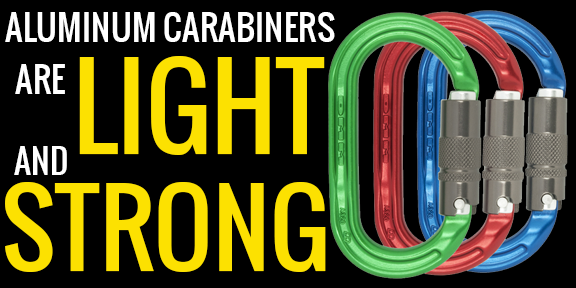
The many Uses of Carabiners
We've talked about carabiners plenty of times in the past and that's for a very good reason; they are really useful! Carabiners have been around since 1921 to help keep things attached to other things as well as keeping climbers attached to ropes on the cliff side or in the canopy. Carabiners have developed into something that we can use for life support, for rigging, and to make our climbing lives way easier! Let's take a look at some of the different uses for the various carabiners that are available.
Aluminum Carabiners
First off, aluminum carabiners make up most of what we use on a day-to-day basis. Aluminum carabiners are very lightweight and very strong, which makes them great for life support. These carabiners attach our eye to eyes to our harness and connect our spliced eyes to our Hitch Climbers. They also attach our Rope Runners to our harness and our Rope Wrenches to our Hitch Climber Pulleys. All of these connections are what keep us from hitting the ground and keep our systems organized and neat.'
The most important things to keep an eye on when using carabiners are sticky gates and cross loading. Gates can become sticky over time, especially if you are doing a lot of Pine or Spruce removals. That nasty sap can get inside of the barrel of your carabiner and keep it stuck open. As you can imagine, if the barrel of your carabiner stays open when you think it's closed, you can quickly get into a really bad spot. Gear inspections are the best way to be sure your carabiners are opening and closing correctly. You can also clean out your carabiners with warm soap and water and then lubricate them with Duck Oil to keep them opening and closing as smooth as ever!
Keeping a close eye on your carabiners while climbing is a great way to keep them from cross loading. Cross loading happens when your carabiner turns sideways and becomes loaded across its minor axis. Usually a carabiner should be loaded from its longest end to its longest end. When a carabiner is turned sideways its strength is greatly reduced. Keep a good eye on your carabiner when climbing to ensure cross loading isn't happening!
Steel Carabiners

The second type of carabiner we are going to discuss are steel carabiners. Steel carabiners are quite a bit heavier than aluminum carabiners, but the trade off is they are also quite a bit stronger. Steel carabiners are typically used for rigging instead of something like a running bowline. The best way to use a steel carabiner for rigging is to throw a half hitch around the limb or log first and then clip the carabiner around the log and back to the rope. The half hitch will take most of the weight instead of all the weight being loaded onto the carabiner.'
Using a carabiner is quick and easy up in the tree for the climber, but it really shines for ground workers. Personally I have noticed that untying knots takes much longer than tying them. Using a half hitch and steel carabiner can really make it speedier for the groundies to get the rope back up to you. One thing to keep in mind about steel carabiners is they are heavy and solid. If you are using them with a block and your ground workers are in the habit of pulling the rope back up to you, BEWARE, that carabiner will fly up the rope at incredible speeds, and if it hits you, you will get hurt!
Accessory Carabiners

Lastly, let's look at some accessory carabiners and tool holders. These carabiners are made of either aluminum or plastic and make a climber's day much smoother! The carabiners are inserted through the webbing on your harness and give the climber a convenient place to store rigging lines, chainsaws, or pruners. This makes everything accessible with one hand and everything is right at your fingertips. One tool holder on each hip will give you tons of storage for anything you need in the tree!
All of these great carabiners can save your life, save you time, and save you headache! We would love to hear what your favorite type of carabiner is and why you like to use it! Let's hear what you have to say in the comments below!

Leave a comment